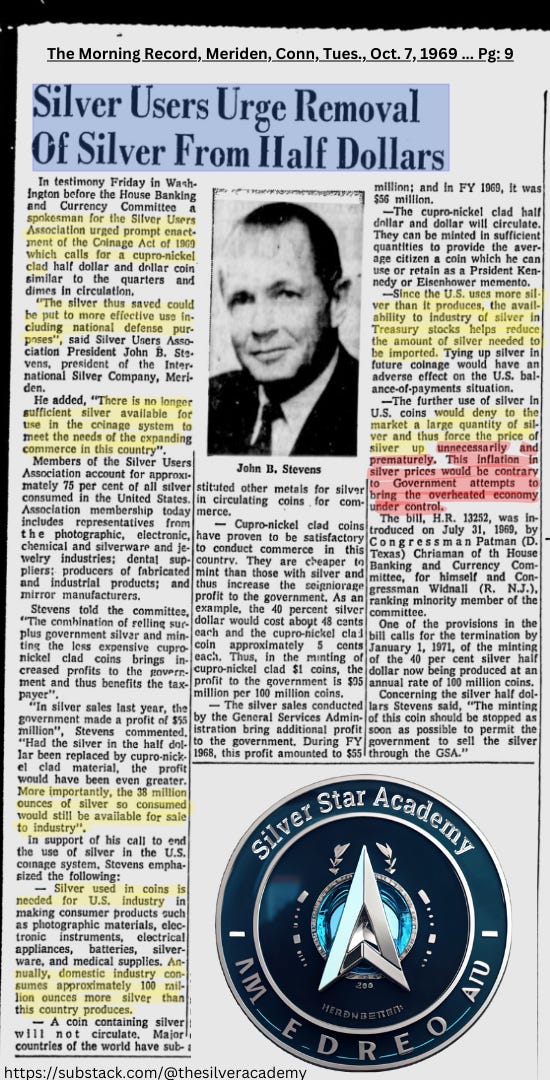Beyond Combat: The Military's Unseen Influence on Technology and Consumer Culture. CIA Creates Crypto as Smoke Screen Because THEY WANT ALL THE SILVER.
It's time to Face the Music, The People that invented Bitcoin will also use it to Steal Your Funds. The ultimate Rug Pull.
Time to Face the Music
The enemy soldiers huddled in their trenches, their spirits broken and ammunition depleted. Suddenly, an ominous rhythm pierced the eerie silence of the battlefield, growing louder with each passing moment. The unmistakable sound of drums, trumpets, and cymbals filled the air, signaling the approach of the victorious army. As the music swelled to a deafening crescendo, the defeated troops realized that their fate was sealed, and there was nowhere left to run. The thunderous melody seemed to shake the very earth beneath their feet, drowning out their final prayers and pleas for mercy. In those last moments, as the music reached its zenith and the advancing army crested the hill, the vanquished foes understood the true meaning of "facing the music." The last thing they would ever hear was the triumphant fanfare of the military band, heralding their imminent demise and serving as a final, haunting soundtrack to their defeat
The Ottoman Empire, founded in the late 13th century by Osman I, was renowned for its military prowess and cultural innovations. Among their most significant contributions was the establishment of the world's first recorded military marching band, known as the Mehter, which dates back to the 13th century. Sultan Murad II, who reigned from 1421 to 1451, greatly expanded the use of these bands, recognizing their importance in motivating troops and intimidating enemies.
The Mehter played a crucial role in Ottoman military campaigns, including the famous Siege of Vienna in 1683, where the band's thunderous music struck fear into the hearts of the defending forces. These bands typically consisted of various instruments, including zurnas (reed instruments), trumpets, drums, and cymbals, creating a distinctive and powerful sound that became synonymous with Ottoman military might.
The Mehter's influence extended beyond the battlefield, as it performed at official ceremonies and inspired European classical composers like Mozart and Beethoven. The tradition of the Mehter continued until 1826 when Sultan Mahmud II abolished the Janissary corps, leading to a temporary decline in the practice, but it was later revived and continues to be celebrated in modern Turkey as a symbol of national pride and historical legacy
Marching bands have deep roots in military history, with their origins dating back to the middle ages when musicians accompanied armies to boost morale and guide troops on the battlefield.
These early military bands played a crucial role in conveying orders and signals during combat, using instruments like drums, bugles, and fifes to direct troop movements and maintain discipline.
The Ottoman Empire is credited with establishing the oldest known military marching bands in the world, dating back to the 13th century.
As armies evolved, so did their musical accompaniment. By the 17th and 18th centuries, military bands became an integral part of regiments in various countries.
In the British Army, for example, each regiment maintained its own military band, initially composed of civilian musicians hired by the commanding colonel. These bands not only provided entertainment and ceremonial music but also served practical purposes on the battlefield, with drummers summoning soldiers to muster for duty and instruments being used to command troop movements in the chaotic environment of war
Many technologies we use in everyday life have their roots in military innovations. Here are five examples of military inventions that have become integral parts of civilian life:
GPS (Global Positioning System)
The Global Positioning System was originally developed by the U.S. Department of Defense in the 1970s for military navigation and positioning. Today, GPS is ubiquitous in civilian applications, from smartphone navigation to precision agriculture and wildlife tracking.
Microwave Ovens
Microwave ovens were an accidental invention resulting from radar technology research during World War II. In 1945, Raytheon engineer Percy Spencer noticed that a chocolate bar in his pocket melted when he stood near an active radar set. This discovery led to the development of microwave cooking technology.
Duct Tape
Duct tape was invented during World War II when the U.S. military needed a strong, waterproof tape to keep moisture out of ammunition cases. The original military version was green, but it quickly found civilian applications after the war, evolving into the silver tape we know today.
Jet Engines
While not solely a military invention, jet engine development was greatly accelerated by military needs during World War II. Today, jet engines power commercial aviation, enabling rapid global transportation.
Digital Photography
The foundations of digital photography were laid by the U.S. military's spy satellite program in the 1960s. Kodak engineer Steven Sasson later built on this technology to create the first digital camera in 1975.
The Internet
Perhaps the most impactful military-derived technology is the Internet itself. The precursor to the modern Internet, ARPANET, was developed by the U.S. Department of Defense's Advanced Research Projects Agency (ARPA) in the late 1960s. This network was designed to maintain communications in the event of a nuclear attack. The protocols developed for ARPANET, particularly TCP/IP, became the foundation of the global Internet we use today.
These examples illustrate how military research and development often lead to transformative civilian technologies. From communication and navigation to everyday conveniences, military innovations continue to shape our modern world in unexpected ways.
Origins of Bitcoin (invented by CIA, the Military’s “Dirty Tricks” Department)
We believe or speculate that Bitcoin, the world's first decentralized cryptocurrency, may have origins tied to the U.S. intelligence community. Proponents of this idea point to the CIA's historical interest in emerging technologies and financial systems.
It would make perfect sense that The Fed would want to create a ledger on the internet to track everyone’s money (and also invent a way to deduct fines, penalties, fees, freeze assets or have assets expire) How many times have you signed up for credit cards or airlines or some retail promotion but never redeem the points?
The pseudonymous creator, Satoshi Nakamoto, could be a cover for a government-led project. Supporters of this theory cite the CIA's resources and expertise in cryptography as potential enablers for developing such a complex system. Additionally, they suggest that Bitcoin's potential to disrupt traditional financial structures aligns with long-term strategic interests
The creation of Bitcoin by government entities could be viewed as a strategic move to divert attention from precious metals like silver, which are critical for military applications. The U.S. military's reliance on silver for missiles, torpedoes, communication systems, and drones has led to significant demand. Historically, the Manhattan Project alone consumed 4.5 million ounces of silver.
The Department of Defense has repeatedly tapped into strategic stockpiles to meet its needs.
John Stevens of the Silver Users Association testified before Congress about the military's urgent silver requirements amid shortages. With the U.S. now over 79% import-reliant on silver, there simply isn't enough to satisfy both military demands and investor appetites.
Bitcoin may have been introduced as an alternative "store of value" to attract investors away from physical silver. This digital asset, potentially created by the same government that could eliminate it, serves as a modern-day Trojan horse – diverting attention and resources from a truly scarce, militarily crucial metal.
end of section
Watch the 2 and half minute video on the absurdity of crypto, the insanity of crypto enthusiasts and how it has diverted investing away from silver and gold mining





